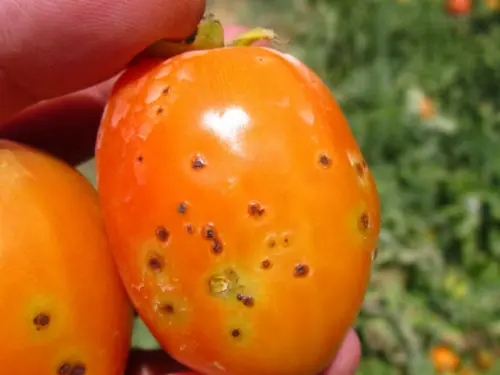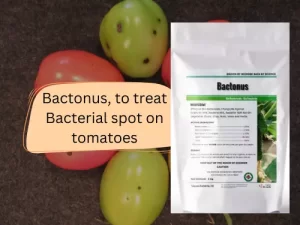Bacterial leaf spot tomato are very dangerous and can stress you out. If the tomato plants are getting weak, you need to check them out. Tomato leaves turning white and a few white spots on them can be an alarming signal. Brown leaves on tomato plants are also something that you should look out for!

Contaminated seeds and transplants can cause bacterial spots in tomatoes. Sometimes, these things show symptoms, and sometimes, they do not. They are usually caused by Xanthomonas vesicatoria, Xanthomonas euvesicatoria, Xanthomonas gardneri, and Xanthomonas perforans. They can be introduced by contaminated seeds and sometimes by plant debris that passes on from one season to another.
Let us find out more about the reasons for bacterial spots in tomatoes. We will also try to find some solutions to resolve this terrible issue.
How does bacterial leaf spot spread?
Bacterial leaf spots on tomatoes can spread just by splashing rainwater or irrigation. It can also spread through plant debris. The bacterial leaf spot causes bacteria to spread easily under the soil and on the surface of the soil. Let us know in details in further parts.
Wet and warm climates
Sometimes wet and warm climates are the reason bacterial leaf spot tomato occur. It leads to the growth of the dangerous bacteria of the Xanthomonas family, spreading bacterial leaf spots throughout the plantation. You can find brown leaves on tomato plants, which is when you need to be alert. If the plantation is not getting proper sunlight, then even tomato seedlings turning white will be the common condition.
Not maintaining the greenhouse
Not maintaining the greenhouse can be hazardous as far as bacterial spots on tomatoes are concerned. It can also lead to moisturization and attack of the bad bacteria. It does not only attack the roots but also the seedling along with the parts above the soil.
Uncleared plant debris

Plant debris can usually follow one season after another. It attracts dangerous bacteria, which find a great initial shelter here and then spread through the whole tomato crop field. Before thinking about what causes spots on tomatoes, it is important that you clear the debris of previous seasons before planting the new tomato plants.
Contaminated tomato seedlings
While getting the new seedlings, always check to verify the contamination issue. If you do not check that, you will be in trouble after you do the plantation. Then you will start checking “What causes tomato leaves to turn white?”! White or brown leaves on tomato plants are only the start, as these bacteria go on to suck the whole plant.
Keeping foliage dry is the best solution. Regular pruning should be done for good circulation of air so that there is no crowding of tomato plants and the foliage stays dry. Keeping away from excessive watering is also necessary. Once you see one plant is affected then pruning it properly is needed or else even pruning can lead to leaf spot disease as the brown leaves on tomato can happen pretty quickly.
How do you treat bacterial leaf spots on tomatoes?
For casual gardening, people using copper products might just do the thing, but it is advisable to use Bactonus for all. Novobac has got Bactonus that has Bacillus velezensis, Bacillus safensis, and Pseudomonas chloraphis. Let us know about the treatment in details in further parts.
Doing foliage treatment
Copper spray can be effective in countering bacterial spots on tomatoes but if you simply use them without anything else constantly then it cannot give the desired results. Plant resistance inducers like Regalia or Actigard can be used with copper sprays to destroy the disease creating bacteria.
Using beneficial microbes to counter bacterial leaf spot in tomato bacteria
People who find bacterial tomato diseases like bacterial leaf spot one happening usually panic. It is justified because it leads to the complete damage of their tomato crops. You can use the beneficial microbes to counter these highly spreading dangerous bacteria. The only moment that can stop you from doing it is that the attack has spread to more than 5 percent of your total tomato plantation. That is when it becomes very tough to suppress.
Use organic fungicide from Novobac to treat bacterial leaf spot tomato
Tomato plants with brown leaves can always cause pain in the heart as you are going to lose out on nutritious tomatoes. Sometimes, you might find tomato leaves going black! Well, when there are terrible bacterial tomato diseases, you can fall on top manufacturers of organic fungicide Novobac. With this reputable manufacturer bacterial leaf spot cure is quite easy.

Novobac has got a good patented bactonus. It is a natural protector of tomato plants against bacterial leaf spot attack. It has Bacillus velezensis, Bacillus safensis, and Pseudomonas chloraphis, which can control many types of fungal and bacterial disease by colonizing the roots of the tomato plants.
Buy the best bio fungicide, like a bonus from Novobac, before brown leaves on tomato plants start to be a common occurrence among all your tomato plants!
Cutworms in gardens are a major menace to all..
As a farmer,I inspect my fields daily to monitor..
It all started with a worried farmer named Mr...

Leave a Reply